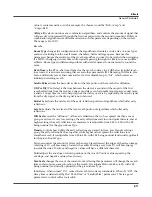
9-24
Effects
Stereo Simulation
Stereo Simulation
The Mono to Stereo algorithm converts a monaural input to simulated stereo output.
In Select
selects the input signal to be “stereo-ized”. It can be Left, Right, or both: (L+R)/2.
CenterGain
is the level of the summed left and right channels. Range is Off/-79.0 to 24.0 dB.
Diff Gain
is the level of the difference signal produced, which is the spatial component of the
stereo signal. Range is Off/-79.0 to 24.0 dB.
DiffBassG
controls the gain of a bass-shelf filter on the difference signal. By boosting the low
frequency components of the difference signal, you can increase the sense of acoustic
envelopment. Range is -79.0 to 24.0 dB.
DiffBassF
is the transition frequency for the bass-shelf frequency. Range is 16 to 25088 Hz.
The processed signal is split into three frequency bands—Lo, Mid, and High—each of which can
be delayed and panned separately.
Crossover1
and
2
are the two Crossover frequencies at which the band-split filters split the
signal into three bands. The two parameters are interchangeable: either may have a higher
frequency than the other. Range is 16 to 25088 Hz.
Pan
[High/Mid/Low]
sets the pan position for each band. Range is -100% (fully left) to 100%
(fully right.)
Delay
[High/Mid/Low]
sets the delay for each band. Range is 0 to 1000 ms.
Stereo Image
This algorithm provides enhancement for a stereo signal. It also features a stereo correlation
meter. It uses some parameters from
Mono to Stereo
and some from
Stereo Analyze
(following).
Stereo Analyze
In this algorithm you can look at the two channels of a stereo signal, and also their inversions,
sums, and differences. You can adjust their gains, and apply small delays to either or both
channels.
L Invert
and
R Invert
inverts the phase of the channels.
L Out Mode
and
R Out Mode
determines which signal is going to be metered and sent to the
output of each of the channels. The choices for each are: “L” (left), “R” (right), “(L+R)/2”
(normalized sum), “(L-R)/2” (normalized difference), and polarity inverted versions of these.
L/R Delay
“time balances” the two signals. At negative values, the right channel is delayed,
while at positive values, the left channel is delayed. The range is -500 to 500 samples.
RMS Settle
controls how fast the RMS (average-reading) meters can rise or fall with changing
signal levels. Range is 0 to 300 dB/second.
Содержание PC3
Страница 24: ...1 6 Introduction Options ...
Страница 50: ...4 4 The Operating Modes Using the Modes ...
Страница 174: ...7 54 Setup Mode The Utility Soft Buttons ...
Страница 178: ...8 4 Quick Access Mode Making Your Own QA Banks ...
Страница 204: ...9 26 Effects Mono Algorithms ...
Страница 266: ...A 2 MIDI Implementation Chart ...
Страница 308: ...Index x ...
















































